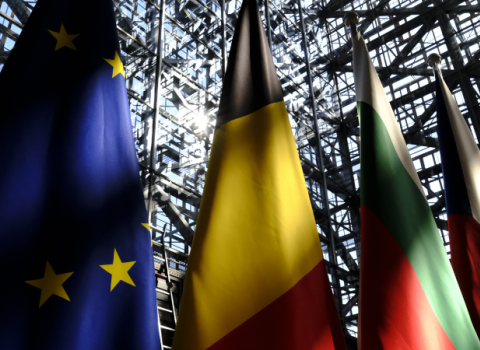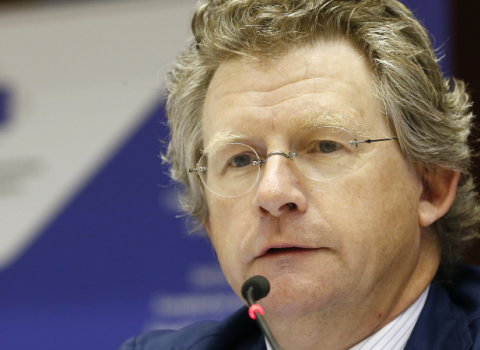Draft plans released by the Commission promise money for several hot-button research areas

Artificial photosynthesis, cloud computing, blockchain and ways to turn windows into solar power plants are just some of the projects in line for funding in new EU research plans.
Amongst the initiatives in the draft plans for 2018 – 2020, it is proposed that the European Innovation Council will reward a prize to researchers who can replicate a natural wonder and develop an artificial form of photosynthesis, involving a bionic leaf that sucks carbon dioxide out of the air to generate energy.
In addition, over the next three years, the EU will begin putting serious money into an EU-wide cloud computing network, a first-in-the-world effort to create an international system for sharing research data from any lab or scientific discipline, making it accessible with just a few clicks.
Money will also flow to SMEs to test new applications of blockchain, the technology at the heart of digital currencies such as Bitcoin, which creates a digital ledger of transactions, agreements and contracts distributed across several, hundreds or even thousands of computers around the world.
All these proposals feature in the draft Horizon 2020 research plans for 2018-2020, which the Commission is publishing online for comment, with final versions expected later this month.
Committees of member states and researchers have developed the work programmes over the past year with the aid of the Commission’s research department. They cover the final three years of Horizon 2020, under which €30 billion will be invested.
Reactions from researchers on the new plans are coming in, with many still wading into the cache of documents. Lobbyists say they expect some changes to competition scheduling and budgets, but not so much to content.
Science|Business does its own deep dive on the latest releases.
Push to reduce cost of renewable energy
In energy the overall aim is to bring down the cost of renewables, with the Commission noting that, “Current renewable fuel technologies are still not competitive compared to technologies of fossil fuel alternatives.”
One specific challenge is to develop transparent solar cells that could turn every window into a power plant.
There will be more money for first-of-a-kind commercial-scale demonstrations of renewable energy systems and for other projects to reduce the cost of solar, wind and geothermal generation.
To further tap Europe’s wave energy potential, there will be funding the design, development and validation of cost-effective wave energy convertors that can survive in harsh and unpredictable seas.
Complimenting this research, there will be a call for proposals to develop new insurance schemes that mitigate the risks involved in geothermal drilling and offshore installations.
The Commission will back the global clean energy project, ‘Mission Innovation’, whose members are committed to sharing information on clean energy R&D, to double government investment in clean energy within five years and to encourage greater levels of private sector investment.
There are also grants for new ways of retrofitting buildings to make them more energy efficient. “Many public authorities, individuals or businesses lack the skills and capacity to set up, implement and finance ambitious low-energy and clean energy building projects,” the Commission notes.
There will be support for Europe’s coal fields to reduce dependence on fossil fuels, diversify their economies and move to more sustainable energy systems.
Currently, public funding accounts for around 19 per cent of energy research funding in the EU, excluding the nuclear sector, with the rest provided by the private sector. Only 4 per cent of this comes from EU programmes.
SME support – more experiments
Brussels will give innovation agencies more money to experiment and develop new services to support SMEs.
“Innovation support agencies rarely engage in policy experimentation, for lack of funds, time pressure to deliver new support, and the fear of a backlash against money wasting,” the Commission says.
There will be funding for a European open innovation network in advanced technologies, featuring a central brokerage service to match the innovation needs of large industries with SMEs that can provide the technologies they are seeking.
Grants will be available for SMEs to employ highly skilled researchers, or innovation associates.
The Commission will devote some of the budget to evaluating two of its SME-targeted programmes, the SME Instrument and Fast Track to Innovation, and on assessing the overall economic impact Horizon 2020 had on companies from 2014-2017.
Cloud gathering
Researchers will be invited to contribute the next building blocks of the EU-wide cloud-computing network, to create an “agile, fit-for-purpose and sustainable service.”
Rather than build its own cloud from scratch, the EU is to fund the interconnection of existing and new European data infrastructures run by commercial and publicly funded organisations and provide the software, metadata, data registries and other tools to glue these existing services together.
Grants will support the connection of the research infrastructures to the cloud, which is to be run by a body made up of government representatives, scientists, and the Commission.
The Commission also intends to set up a legal vehicle to oversee the cloud and proposals for the rules of participation and decision-making are invited.
European Data Infrastructure
Complementing its investment in the cloud, the Commission will put €22 and €24 million into the European Data Infrastructure, to modernise high-bandwidth networks, upgrade data storage facilities and boost super computer capacity.
There will also be money to support development of new large scale research infrastructures and to upgrade existing facilities.
Nuclear future
The EU will continue to back research on safety, waste management, radiation protection, education and training in civil applications of nuclear power as part of its Euratom programme. There is also money for decommissioning old nuclear plants.
On safety, there will be a specific project on cellular damage caused by ionising radiation from nuclear waste.
A ‘Soft Innovation Prize’ will reward excellence in fusion research and the EU will continue contributing funding to the world’s largest fusion experiment, the International Thermonuclear Experimental Reactor (ITER), in southern France.
Nearly 30 per cent of the EU's electricity comes from nuclear plants. “The EU should ensure that it maintains technological leadership in the nuclear domain, including through ITER, so as not to increase energy and technology dependence,” the draft plan says.
There is money for an assessment of open data requirements within the fusion programme, to establish the best technical approaches for providing easy access to data and to develop the tools required to implement an open data policy.
There will also be more research cooperation with Ukraine, which joined Euratom in 2016.
Building research ties with Russia
The Commission wants to apply science diplomacy to defrost the current frigid relationship between Europe and Russia, by pledging money for Russian research labs and travel and subsistence costs for European researchers who want to visit them. It is looking for proposals for a staff exchange programme and summer schools with Russia scholars.
Russia’s participation in EU research has gone down compared to 2007-2013. One explanation is thought to be a change in the rules, to require Russia to help fund joint research projects.
Researcher exchange programmes
The EU will continue to support a broad range of training and career development opportunities, such as joint industry-university doctoral programmes, in its Marie-Curie programme.
Postdoctoral fellowships will support the return and reintegration of European researchers working abroad and researchers displaced by conflict outside the EU. Particular attention will be given to applicants who have taken at least a year out of research for parental leave.
Marie-Curie is probably the most popular EU research competition. The programme, which makes up 8 per cent of the Horizon 2020 budget, is massively over-subscribed and 80 per cent of all proposals do not get funded.
Projects funded through Marie-Curie have resulted in 1,114 publications, the highest number of any area in Horizon 2020.
Taking the plunge for a sustainable future
A new financial vehicle is among the proposals in the plan for food security, sustainable agriculture, forestry, marine, maritime and bioeconomy research, which will receive total funding of €1.3 billion
As part of this investment, the EU’s InnovFin Holding Fund is to set up a €50 million fund dedicated to bioeconomy projects. Here, the focus will be on bio-based industries and the blue economy, taking produce from the land and sea and developing innovative processes to create further value from them.
The Commission is also committing to support several, big international research initiatives, with continued investment in the EU-Africa Partnership on Food and Nutrition Security and Sustainable Agriculture and more funding for the EU-China Food, Agriculture and Biotechnology Flagship initiative.
Marine and maritime science remains a strong focus and the plan includes several initiatives in this area, including a new Atlantic Ocean research alliance.
The description of Mission Innovation in this article was corrected on 11 October.





 A unique international forum for public research organisations and companies to connect their external engagement with strategic interests around their R&D system.
A unique international forum for public research organisations and companies to connect their external engagement with strategic interests around their R&D system.